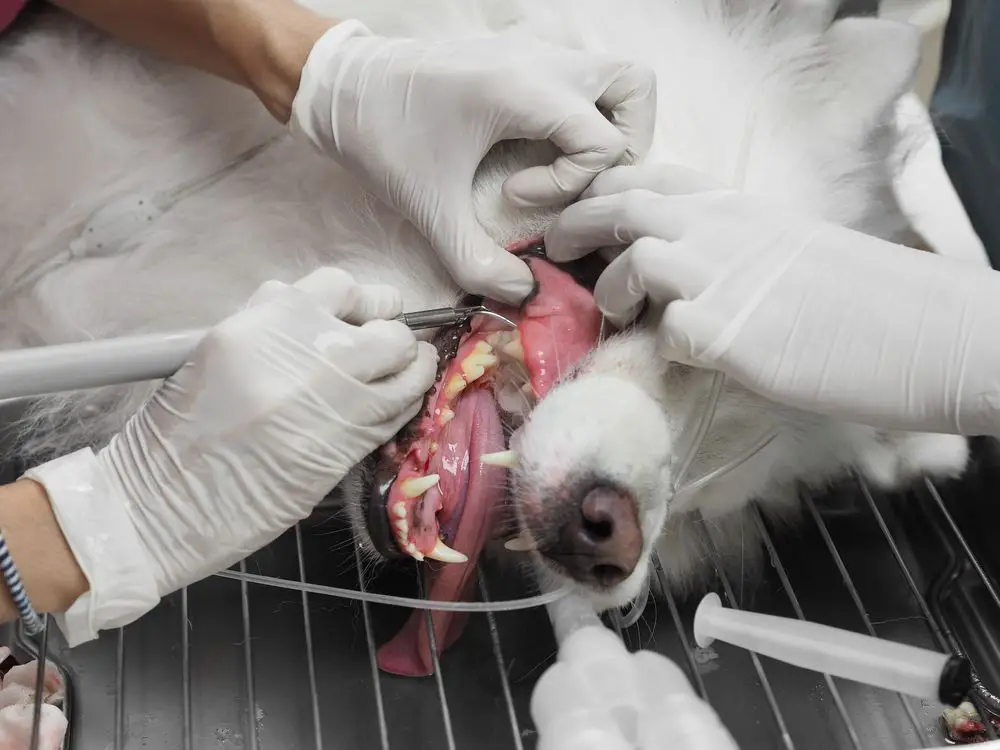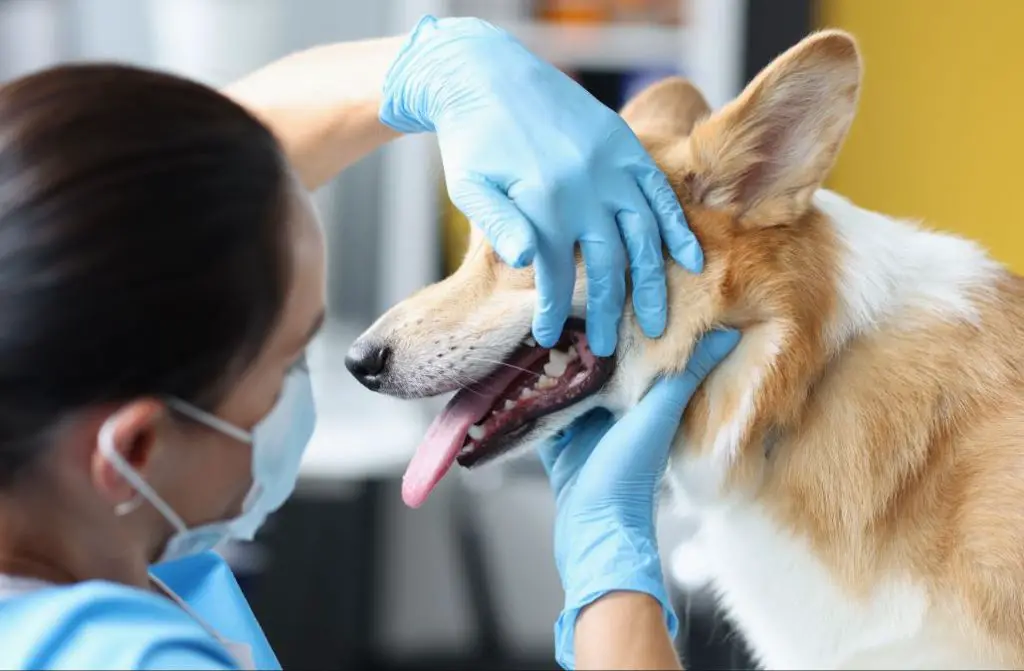Introduction
Dental cleanings are an important part of preventative care for dogs. Over time, plaque and tartar can build up on a dog’s teeth, leading to bacteria, gum disease, and tooth decay. To properly clean the teeth, most veterinarians recommend a thorough dental cleaning while the dog is under anesthesia.
During the dental cleaning procedure, the veterinarian will scale the teeth to remove tartar above and below the gumline. X-rays may be taken to check for problems below the surface. The teeth will be polished to smooth them out. Any damaged or infected teeth may need to be extracted.
To keep the dog safe and comfortable under anesthesia, intravenous (IV) fluids are often administered. This helps maintain normal blood pressure, delivers extra fluids, and allows easy administration of medications if needed. However, some pet owners may question if IV fluids are really necessary, especially considering the additional costs.
What is a Dog Dental Cleaning?
A dog dental cleaning is a procedure performed by a veterinarian to thoroughly clean a dog’s teeth and gums. It involves putting the dog under general anesthesia so the vet can fully examine the oral cavity and clean buildup off the teeth down to the gumline. This buildup is called plaque and tartar and contains bacteria that can lead to infection and tooth decay if not removed.
During a dental cleaning, the veterinarian will:

- Place an IV catheter and begin intravenous fluids to help maintain blood pressure during anesthesia
- Induce anesthesia, usually with an injection of propofol
- Intubate the dog to ensure an open airway
- Use dental scaler tools to clean plaque and tartar off the teeth, both above and below the gumline
- Use a polisher to smooth teeth surfaces
- Examine each tooth and grade any problems noted
- Take dental x-rays as needed to evaluate the tooth roots and bone
- Extract any badly damaged or infected teeth
- Rinse thoroughly and apply fluoride treatment
- Monitor anesthesia and vital signs throughout procedure
- Recover the dog safely from anesthesia
The anesthesia allows the vet to be thorough and safe while cleaning the teeth. The dog remains asleep and pain-free during the potentially uncomfortable cleaning and dental exam process.
Why are IV Fluids Used?
IV fluids are commonly used during dental cleanings and other procedures that require anesthesia to help support the body and maintain normal functions.

There are two main reasons IV fluids are given:
Prevent Dehydration
Anesthesia can cause dehydration by lowering blood pressure and decreasing blood circulation. Fluids help counteract this effect by replenishing the body with hydration.
Maintain Blood Pressure
Anesthesia also causes blood pressure to drop. IV fluids help maintain normal blood pressure levels during the procedure.
By preventing dehydration and stabilizing blood pressure, IV fluids help minimize the risks associated with anesthesia in dogs undergoing dental cleanings and other procedures.
Risks of Anesthesia
Anesthesia always carries some inherent risks, even for routine procedures like dental cleanings. While veterinary anesthesia has become very safe, especially with modern monitoring equipment, there is still a small chance of complications. This is because anesthesia depresses respiratory and cardiovascular function to induce unconsciousness.
Some potential side effects of anesthesia include:
- Low blood pressure
- Slowed breathing or respiratory arrest
- Slowed heart rate or cardiac arrest
- Reduced body temperature (hypothermia)
- Nausea and vomiting
These risks are quite rare with today’s anesthesia protocols and veterinary monitoring. But they demonstrate why anesthesia is never completely without risk. IV fluids help provide support against some of these potential complications.
Benefits of IV Fluids
Providing intravenous (IV) fluids during anesthesia for dental cleanings in dogs offers some key benefits. The two main advantages are a quicker recovery time and prevention of dehydration.

IV fluids help replace the loss of fluids that occurs during anesthesia and surgery. This helps dogs recover more quickly compared to receiving no fluids at all. The IV fluids also help prevent dehydration, which is a risk during any procedure requiring anesthesia.
Overall, IV fluid administration allows the dog’s circulatory system to function better. This maintains normal blood pressure levels during the dental procedure. It also helps the dog’s body metabolize and excrete the anesthetics more efficiently. This enables a faster recovery once the procedure is complete.
While not all veterinarians require IV fluids for routine dental cleanings, they are generally recommended. The faster recovery and prevention of dehydration they provide make IV fluid administration a beneficial part of the anesthesia protocol for dental procedures in dogs.
Downsides of IV Fluids
While IV fluids administered during dental cleanings provide benefits, there are some potential downsides to consider:
-
Added costs – IV fluids, IV catheters and the associated nursing support and monitoring all add cost to the dental procedure. This can sometimes add several hundred dollars to the total bill.
-
Longer procedure time – It takes time to place an IV catheter, monitor the fluids during the procedure, and remove the catheter afterwards. This lengthens the time your dog is under anesthesia and the time required for the overall procedure. For very quick cleanings of less than 30 minutes, the extra time for fluids may not be warranted.
These factors may make IV fluids unnecessary for young, healthy dogs undergoing quick dental cleanings. Discuss the pros and cons with your veterinarian.
When are IV Fluids Necessary?
IV fluids are usually recommended for older dogs undergoing anesthesia for dental cleanings. As dogs age, their kidney and liver function declines naturally. Anesthesia can place additional stress on these organs, increasing the risk of issues during or after the procedure. IV fluids help support kidney and liver function, keeping the dog hydrated and minimizing risks.
Dogs with pre-existing medical conditions like heart disease, kidney disease, or diabetes will also benefit from IV fluid support. Their compromised organ function means anesthesia poses greater risks. IV fluids provide extra protection and can mean the difference between life and death.
For dental cleanings requiring long anesthesia times, IV fluids help counteract the effects of prolonged sedation. Cleanings that involve extensive tooth extractions or oral surgeries can take several hours under anesthesia. IV fluid administration ensures the dog’s blood pressure remains stable and organs stay healthy despite extended anesthesia exposure.
When Can IV Fluids Be Avoided?
IV fluids may not be necessary for short, routine cleanings in healthy dogs. If your dog is young, has no underlying health conditions, and is only getting a basic teeth cleaning that will take less than an hour, then your vet may determine that IV fluids are not required.
Healthy dogs that are cleared for anesthesia by pre-procedure bloodwork and exam may be able to undergo short dental cleanings without fluids. This is because the risks of anesthesia complications are lower in dogs that are young and otherwise healthy.
Additionally, cleanings that will take less than an hour put less stress on the body compared to longer, more complex procedures. The short duration means less anesthesia exposure as well.
Finally, dogs that are fasted appropriately prior to the cleaning are less likely to have issues with anesthesia compared to dogs that still have food in their stomach. Proper fasting helps reduce the risks.
Talk to your vet about whether IV fluids can be avoided for your dog’s routine cleaning based on their age, health status, procedure duration, and fasting. While they do provide benefits, they may not be absolutely necessary in low-risk cases.
Discussion with Your Vet
When deciding whether IV fluids are necessary for your dog’s dental cleaning, it’s important to thoroughly discuss the risks and benefits with your veterinarian. Every dog is unique, so consider your pet’s overall health and medical history when evaluating the need for IV fluids.

Factors like age, pre-existing conditions, and procedure length can increase anesthesia risks. IV fluids help support blood pressure and hydration during the procedure. However, they also carry risks like fluid overload. Your vet can help determine if the benefits outweigh the risks given your dog’s health profile.
Provide your vet with a full account of any medical issues your dog faces. Be transparent about at-home care and ask questions. The more information you provide, the better your vet can assess anesthesia needs. Voice any concerns you may have as well.
While some vets recommend IV fluids for all dental cleanings, others may reserve them for higher risk patients. There is no universally agreed upon protocol. Discuss all options to make the most informed decision together with your vet.
With an open and thorough vet discussion, you can best determine if IV fluids are right for your dog’s teeth cleaning based on their unique needs and health status.
Conclusion
During a dog teeth cleaning procedure, IV fluids can provide valuable support to help your dog recover smoothly from anesthesia. IV fluids help maintain blood pressure, replace fluids lost during anesthesia, and increase circulation. For most healthy dogs having a routine teeth cleaning, IV fluids are optional and may not be required. However, they are highly recommended for senior dogs, dogs with pre-existing conditions, and extensive procedures. Discuss your dog’s case with your veterinarian and weigh the pros and cons of IV fluids based on the risks and benefits. Every dog is different, so work with your vet to determine the best treatment approach. With proper preparation and care, your dog can undergo a safe, successful teeth cleaning.